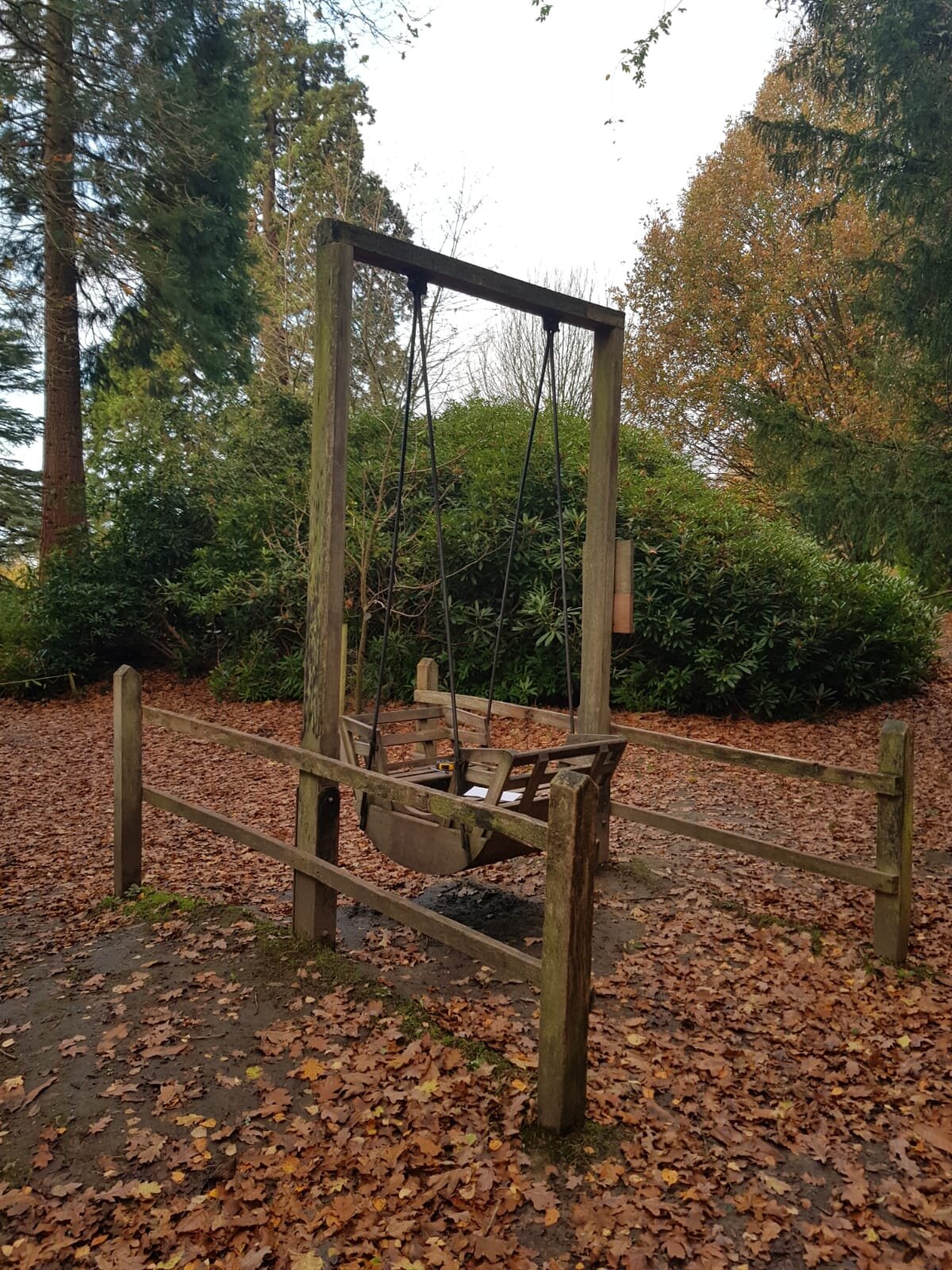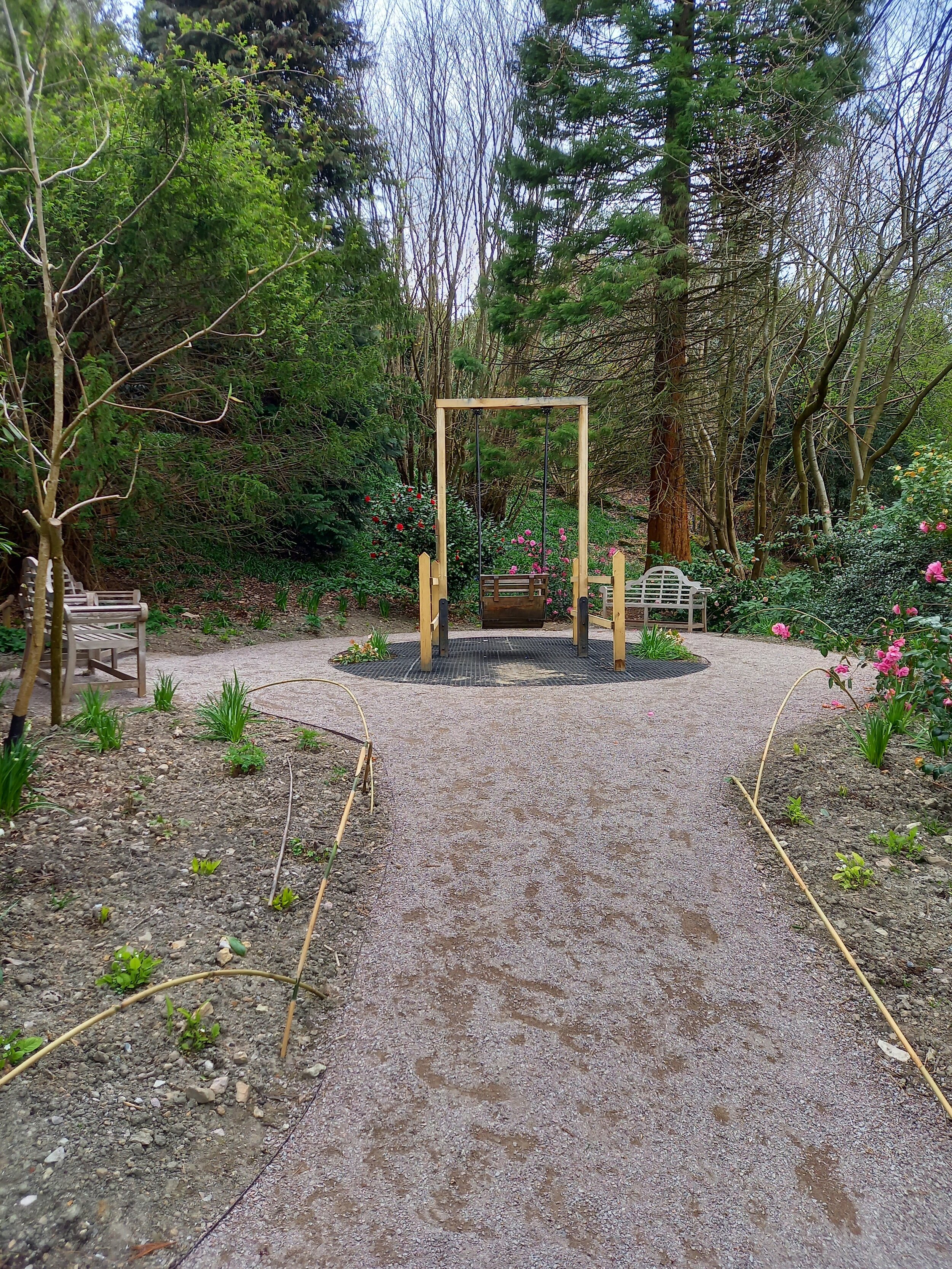Head Gardener's Blog: Winter Projects 2020/2021
The best seat in the house - the newly restored ‘bus shelter’
Whilst working in the gardens one of the most common questions I get asked by visitors is "Do you work all through the winter?" My answer is always the same "Winter is when all the hardest work is done." At Riverhill the Rogers and I, as head gardener, always strive to use the winters to improve an area or several areas of the garden that have been neglected over the past decades. And this winter just gone was no different.
The first area outlined for improvement was the boat swing and Camellia glade. It is an area that is much enjoyed by the younger visitor but didn't provide much for others and, since the rock garden has been renovated, it is visited much more frequently. Unfortunately, when the boat swing was originally installed, about 10 years ago, the area wasn't levelled out and therefore was particularly lumpy and bumpy and could also get rather muddy at times. The boat swing and its frame was also showing signs of wear and tear.
So, first thing was to dismantle the boat swing and rebuild it using green oak. This was expertly done by our resident handy man (and expert grass cutter!) Alan.
The area was then levelled, fortunately with the aid of a digger, and a path edge installed. Once the edge was in place the path stone was painstakingly brought in by wheelbarrow and compacted down. As well as tons and tons of soil for backfilling and landscaping the outer areas.
Lastly the area was planted up with a few more Camellias as well as some Sarcococca, Fuchsia, Helleborus, Camassia, Geraniums, Hostas and a host of other perennials.
The newly restored bus shelter, showing the new planting scheme.
The second area to be renovated was the bus shelter (it is not actually a bus shelter but it does rather resemble one) and its adjacent border. The bus shelter roof leaked so therefore needed replacing but upon taking the roof off we discovered the walls were also in need of some work. Fortunately, Alan worked his magic and he soon had the walls vertical again and shortly after re-roofed.
The border that is adjacent to the bus shelter had previously been gardened by Eve Rogers some 40 years ago but had not been maintained in the years since and very little of the planting remained. In fact the trees on the bank behind had grown right over the border in the intervening years. This growth had to be chopped back to allow more light into the border and in doing so uncovered a lovely bench built into the wall, that even the current generation of Rogers didn't know existed. One of the pillars of the bench had collapsed so was rebuilt by a stonemason.
Once the bench was restored the last thing to do was to plant up the border. The only surviving plants in the border were an old climbing rose, that I managed to re-train to grow up one of the trees on the bank, and a Hebe salicifolia that was growing at an odd angle over the path. This was a nice plant so I decided to lift it and replant it towards the back of the border. This left a relatively blank canvas for the rest of the border, which I filled with a mix of shrubs and herbaceous perennials. This was to compliment the border nearby that overlooks the Walled Garden, that had been planted up last spring. One new addition that warrants a special mention is Eremurus himalaicus, or Himalayan foxtail lily. For those unfamiliar with foxtail lilies, it produces a 6ft tapering plume of white flowers shaped much like a rocket in late spring and early summer, definitely one to look out for!
The Azalea Bank, ft. Troy Rogers
The boat swing and the bus shelter were by far the biggest areas to be renovated but not the only ones. Two other areas got planted up over the winter, the first of which is now what I refer to as the Azalea bank. This had previously been a bank of laurels that was at the entrance to the wood garden, that, in my opinion, didn't do the rest of the wood garden justice. So, the laurels were dug out and five varieties of late flowering Azaleas were planted. Along with a Styrax (snowbell tree), Amelanchiers (Snowy mespilus), Deutzias and a Eucryphia.
The other area to be planted up was the area to the south of the rock garden that is known by the family as Muriel’s rose garden. This area was originally planted up shortly after the rock garden was completed in 1908 with an elaborate rose garden including climbing roses growing over trellising and thatched summerhouse. However much like the rock garden it fell into disrepair in the 1950's when there was a lack of funds to maintain the gardens, and unfortunately there is no evidence left of the rose garden.
The planting for this area includes a Cornus controversa, wedding cake tree, as the one focal point with a mixture of Camellias, Hydrangeas and Amelanchiers planted around it and Cornus canadensis, Trilliums, Matteuccia and Digitalis inter-planted.
As I hope you can appreciate all this work has been a huge undertaking but also requires a massive investment from the family in order to attempt to restore the gardens to something of their former glory. All this time, effort and investment has been richly rewarded this year with Riverhill being shortlisted for the Historic Houses Association 'Garden of the Year 2021'. The winner is decided by public vote, you do not need to be a HHA member to vote and we would be very grateful if you would click here to vote for us now. Voting closes 30th September.
Happy gardening!
Adam






